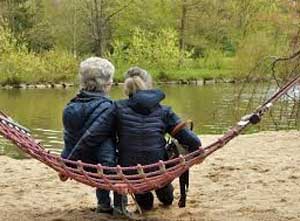- Home
- Editorial
- News
- Practice Guidelines
- Anesthesiology Guidelines
- Cancer Guidelines
- Cardiac Sciences Guidelines
- Critical Care Guidelines
- Dentistry Guidelines
- Dermatology Guidelines
- Diabetes and Endo Guidelines
- Diagnostics Guidelines
- ENT Guidelines
- Featured Practice Guidelines
- Gastroenterology Guidelines
- Geriatrics Guidelines
- Medicine Guidelines
- Nephrology Guidelines
- Neurosciences Guidelines
- Obs and Gynae Guidelines
- Ophthalmology Guidelines
- Orthopaedics Guidelines
- Paediatrics Guidelines
- Psychiatry Guidelines
- Pulmonology Guidelines
- Radiology Guidelines
- Surgery Guidelines
- Urology Guidelines
Women best placed to reach 90 with just 60 minutes of daily exercise

A new study published in the Journal of Epidemiology and Community Health has revealed that 60 minutes of daily physical activity was associated with the best chance of reaching 90 for women.The body size and physical activity were related to the likelihood of reaching 90 years of age and that these associations differed by sex.
The findings indicated that the more time men spent on physically active every day, the better were their chances of reaching old age, whereas 60 minutes of physical activity per day was associated with the best chance for women.
Previous research has looked at the associations between weight (BMI or body mass index), physical activity, and reaching old age, but most studies have combined both sexes, or focused exclusively on men. Women and men’s lifespans differ, which may be influenced by factors such as hormones, genes and/or lifestyle.
Average life expectancy has risen over the past few decades but has recently started to plateau in some developed nations, with increasing levels of obesity and physical inactivity thought to be behind the trend.
Read Also: Regular meditation in early life improves attention & focus in old age
The rising number of obese and/or physically inactive individuals might negatively impact human lifespan. The study assessed the association between height, body mass index (BMI) and non-occupational physical activity and the likelihood of reaching 90 years of age, in both sexes separately.
The researchers analyzed data from the Netherlands Cohort Study (NLCS), which included more than 120,000 men and women aged between 55 and 69 when it began in 1986.
They wanted to see if there were any links between height, weight, leisure time physical activity, and the likelihood of reaching the age of 90 and if there were any differences between men and women.
Some 7807 participants (3646 men and 4161 women aged between 68 and 70) provided detailed information in 1986 on their current weight, height, weight when aged 20, and their leisure time physical activity.
This included activities such as gardening, dog walking, DIY (home improvements), walking or cycling to work, and recreational sports, which were grouped into categories of daily quotas: less than 30 minutes; 30 to 60 minutes; and 90 minutes or more.
Participants were then monitored until death or the age of 90, whichever came first. The researchers considered potentially influential factors, such as whether the participants were current or former smokers, how much they drank, their educational attainment, and usual energy intake.
Some 433 men (16.7%) and 944 women (34.4%) survived to the age of 90.
Read Also: Sensory loss in old age – a warning sign of poor health outcomes including death
The study found that women who were still alive by this age were, on average taller, had weighed less at the start of the study, and had put on less weight since the age of 20 than those who were shorter and heavier.
Women who were more than 175 cm (5 feet 9 inches) in height were 31 percent more likely to reach 90 than women less than 160 cm ( 5 feet 3 inches) while no such associations were seen among the men.
And when it came to physical activity levels, men who clocked up over 90 minutes a day were 39 percent more likely to reach 90 than those who did less than 30 minutes. And every extra 30 minutes of daily physical activity they racked up was associated with a 5 percent increase in their chances of turning 90.
But this wasn't the case for women. Those who chalked up more than 30-60 minutes a day were 21 percent more likely to reach 90 than those managing 30 minutes or less. But there seemed to be an optimal threshold for women: around 60 minutes a day was associated with the best chance of their celebrating the 90th birthday.
"The findings are based on large numbers of people, all of whom were similar in age, which strengthens the results. Our study is one of only a few to different lifestyle factors potentially associated with a long life between men and women, "write the authors.

Disclaimer: This site is primarily intended for healthcare professionals. Any content/information on this website does not replace the advice of medical and/or health professionals and should not be construed as medical/diagnostic advice/endorsement or prescription. Use of this site is subject to our terms of use, privacy policy, advertisement policy. © 2020 Minerva Medical Treatment Pvt Ltd